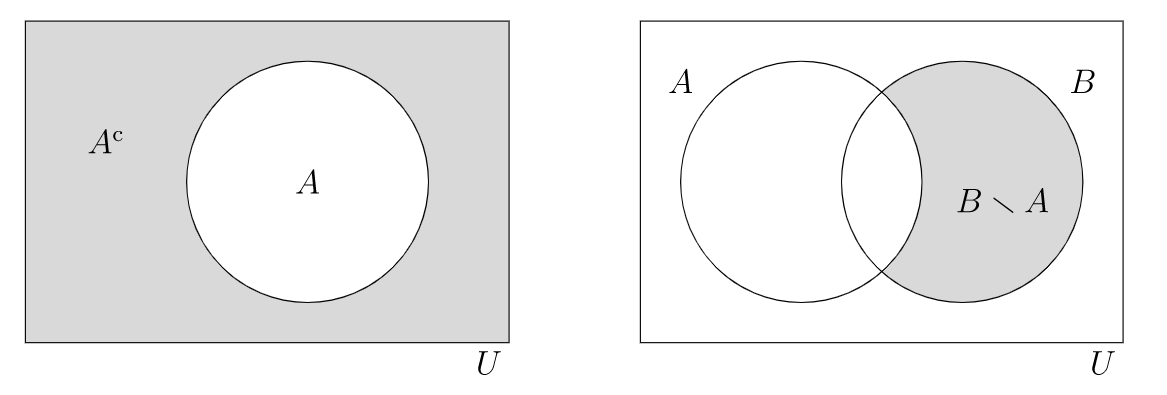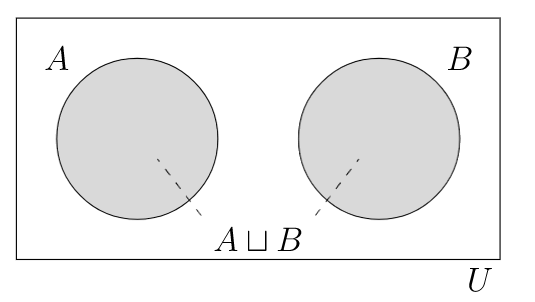9.4: Complement, union, and intersection
( \newcommand{\kernel}{\mathrm{null}\,}\)
First, it is often convenient to restrict the scope of the discussion.
a set that contains all objects currently under consideration
We will consider all of the following set operations to be performed within a universal set U. In particular, suppose A,B⊆U.
9.4.1: Universal and relative complement
the set of elements of U which are not in A
the complement of A (in U), so that
AC={x∈U|x∉A}
if A,B⊆U, the complement of A in B is the set of elements of B which are not in A
the complement of A in B, so that
B∖A={x∈B|x∉A}

Another common notation for relative complement is B−A. However, this conflicts with the notation for the algebraic operation of subtraction in certain contexts, so we will prefer the notation B∖A.
- Suppose B={1,2,3,4,5,6} and A={1,3,5}. Then B∖A={2,4,6}.
- The complement of the set of rational numbers Q inside the set of real numbers R is called the set of irrational numbers, and we write I=R∖Q for this set. If you are thinking of real numbers in terms of their decimal expanions, the irrational numbers are precisely those that have nonterminating, nonrepeating decimal expansions.
9.4.2: Union, intersection, and disjoint sets
the combined collection of all elements in a pair of sets
the union of sets A and B, so that
A∪B={x∈U|x∈A or x∈B (or both)}
the collection of only those elements common to a pair of sets
the intersection of A and B, so that
A∩B={x∈U|x∈A and x∈B}

A union contains every element from both sets, so it contains both sets as subsets:
A,B⊆A∪B.
On the other hand, every element in an intersection is in both sets, so the intersection is a subset of both sets:
A∩B⊆A,B.
For subsets A={1,2,3,4} and B={3,4,5,6} of N, we have
A∪B={1,2,3,4,5,6},A∩B={3,4}.
Consider the following subsets of N.
E={n∈N|n even}P={n∈N|n prime, nNe0}O={n∈N|n odd}T={3n|n∈N}={0,3,6,9,…}
Then,
E∪O=N,E∩P={2},E∩T={6n|n∈N},E∩O=∅,O∩P=P∖{2},O∩T={6n+3|n∈N}.
sets that have no elements in common, i.e. sets A,B such that A∩B=∅
a union A∪B where A and B are disjoint
the disjoint union of sets A and B

Sets E,O from Example 9.4.3 are disjoint, and N=E⊔O.
If A⊆U, then we can express U as a disjoint union U=A⊔AC. Similarly, if U=A⊔B, then we must have B=AC.
9.4.3: Rules for set operations
Suppose A,B,C are subsets of a universal set U. Then the following set equalities hold.
- Properties of the universal set.
- A∪U=U
- A∩U=A
- Properties of the empty set.
- A∪∅=A
- A∩∅=∅
- Duality of universal and empty sets.
- UC=∅
- ∅C=U
- (AC)C=A
- Idempotence.
- A∪A=A
- A∩A=A
- Commutativity.
- A∪B=B∪A
- A∩B=B∩A
- Associativity.
- (A∪B)∪C=A∪(B∪C)
- (A∩B)∩C=A∩(B∩C)
- Distributivity.
- A∩(B∪C)=(A∩B)∪(A∩C)
- A∪(B∩C)=(A∪B)∩(A∪C)
- (A∪B)∩C=(A∩C)∪(B∩C)
- (A∩B)∪C=(A∪C)∩(B∪C)
- DeMorgan's Laws.
- (A∪B)C=AC∩BC
- (A∩B)C=AC∪BC
- Proof of Rule 9.a.
-
Recall that to prove this set equality, we need to show both
(A∪B)C⊆AC∩BC,AC∩BC⊆(A∪B)C.
Show (A∪B)C⊆AC∩BC.
We need to showx∈(A∪B)C⇒x∈AC∩BC.
If x∈(A∪B)C then by definition of complement, x∈U but x∉A∪B. Then x∉A must be true, since if x were in A then it would also be in A∪B. Similarly, x∉B must also be true. So x∈AC and x∈BC; i.e. x∈AC∩BC.
Show AC∩BC⊆(A∪B)C. We need to show
x∈AC∩BC⇒x∈(A∪B)C.
If x∈AC∩BC then by definition of intersection, both x∈AC and x∈BC are true.; i.e. x∉A and x∉B. Since A∪B is all elements of U which are in one (or both) of A,B, we must have x∉A∪B. Thus x∈(A∪B)C.
- Proofs of the other rules.
-
These are left to you, the reader, in the Exercise 9.9.1.
Compare the set operation rules of the proposition above with the Rules of Propositional Calculus.



